A Fabric of Vitruvian Principles
Workin Progress 2019
This study offers a contemporary re-reading of Vitruvian principles through new materialist concepts in order to understand them better and reveal their agencies in design. In the first book of De Architectura, where Vitruvius shapes his theoretical framework of architecture, he gives his famous principles of architecture; he says that architecture depends on ordinatio - taxis in Greek -, dispositio – diathesis in Greek, eurythmia, symmetria, decor, and distributio – oeconomia in Greek-, and an architecture built within these principles should display qualities of firmitas, utilitas, and venustas. Despite their importance in architectural theory and history, it is argued that Vitruvian principles have remained enigmatic for modern readers due to the semantic, linguistic, and cultural challenges of translating them. However, the problem is more troublesome than merely the translation of the principles. This work argues that the problem is that the existing body of analytical work produced on the principles follow reductive approaches emerged in organicist theories, which consider the principles as independent parts of a whole. Current literature reduces the theoretical whole of Vitruvian design to individual principles.
![]() Figure 1: A wine cup (kylix) with satyr fluting a column. Greek (Athens) circa 475 BC. Exhibited in Boston Museum of Fine Arts.
Figure 1: A wine cup (kylix) with satyr fluting a column. Greek (Athens) circa 475 BC. Exhibited in Boston Museum of Fine Arts.
On the other hand, this work sees Vitruvian principles as entangled members of a network in which the interaction between the principles is more important than the principles themselves. It aims at studying the interwoven relationships among Vitruvian principles in order to gain an insight into the agency of these principles in design. This work uses new materialist concepts including, assemblage, agency, entanglement, and intra-action to study conceptual knots and strands in the network of Vitruvian principles. In conclusion, it claims that Vitruvian principles form a fabric in which they are continually performing and interacting inseparably.![]() Figure 2: A diagram illustrating the weaker and stronger interactions between principles.
Figure 2: A diagram illustrating the weaker and stronger interactions between principles.
On the other hand, this work sees Vitruvian principles as entangled members of a network in which the interaction between the principles is more important than the principles themselves. It aims at studying the interwoven relationships among Vitruvian principles in order to gain an insight into the agency of these principles in design. This work uses new materialist concepts including, assemblage, agency, entanglement, and intra-action to study conceptual knots and strands in the network of Vitruvian principles. In conclusion, it claims that Vitruvian principles form a fabric in which they are continually performing and interacting inseparably.
 Figure 2: A diagram illustrating the weaker and stronger interactions between principles.
Figure 2: A diagram illustrating the weaker and stronger interactions between principles.